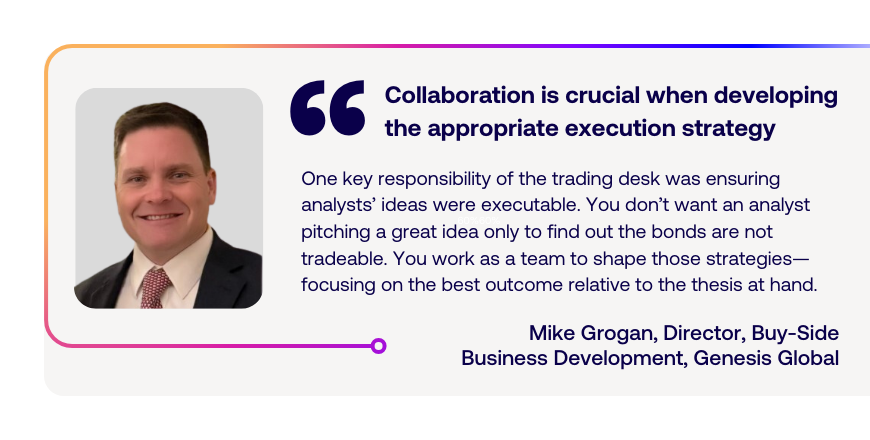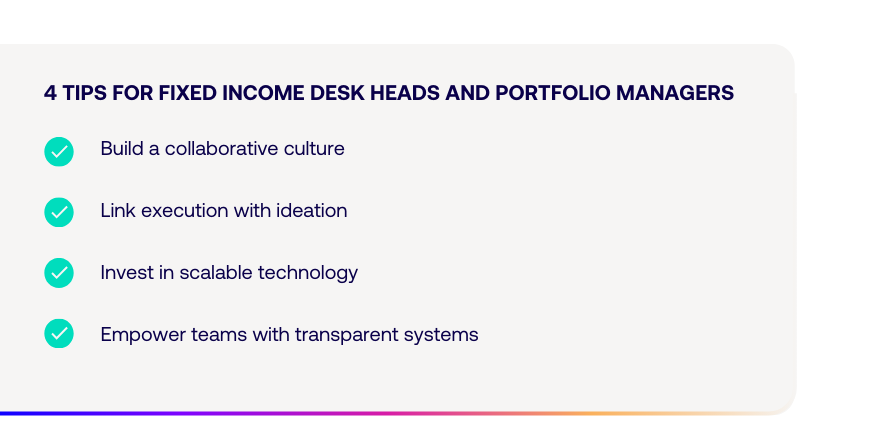
Table of Contents
The world of fixed-income trading is a fast-paced and high-stakes environment where decisions need to be made quickly, compressing hours of analysis into compact windows and where decisions must be made in mere minutes. The pressure to identify opportunities, manage risk and ensure seamless execution is high. And while technology has alleviated some old challenges, new ones have emerged in its place.
For those in the industry, you’ll understand the worrying about unidentified risks, system gaps, and the integration of high-conviction ideas across portfolios. The good news is that success in this field is achievable—not by eliminating every challenge but by adopting strategies that mitigate them effectively.
In this blog, we explore insights from Mike Grogan, ex-co-head of US Fixed Income Trading at T Rowe Price including the main pain points that kept him and other traders and portfolio managers up at night. More importantly, we offer actionable steps to overcome these hurdles and thrive in today’s competitive fixed-income markets.
The hidden risks lurking in fixed income trading
1. Silos stifling high-conviction ideas
Within large buy-side institutions, collaboration is key. Yet, it’s common for promising trade ideas to remain stuck within one silo. If an analyst identifies an alpha-generating opportunity, how does that idea benefit the broader team? Similarly, portfolio managers often grapple with the challenge of ensuring the best strategies reach every relevant portfolio.
When insights and execution are misaligned, opportunities are wasted, and performance can stagnate. Clients increasingly demand transparency about how the best ideas are integrated into their portfolios, further amplifying the pressure.
2. The trade errors you didn’t see coming
The trade errors introduced by misentered data or typos are not the main concern. It’s the unknown trade error—that subtle, overlooked mismatch or misdirection in execution or records—that keeps traders awake.
Often these errors occur due to what’s known as the “Swiss Cheese Model” of failure, where multiple small lapses line up to create a much larger problem. For instance, trade details that appear accurate in isolation might harbor discrepancies when integrated into the bigger system. Errors can go unnoticed until long after the damage is done.
3. System gaps in a fragmented electronic world
The ongoing shift toward electronification in capital markets can significantly improve workflows, but the buy-side, especially, is a sector that lags. And, in a world with partial electronification, technology hasn’t yet eliminated complexity; in some ways, it has magnified it. Different platforms, systems and tools create fragmented data and disparate workflows, making it harder to ensure that no trade or piece of data falls through the cracks.
Instead of streamlining processes, poorly integrated systems can exacerbate risks. Gaps between trading platforms, research systems, and risk management applications result in inefficiencies, miscommunication, and missed opportunities.

4. Execution risks with limited visibility
Even the greatest trade idea is worthless if it’s not executable. Fixed-income traders constantly worry about liquidity across varying scenarios. Liquidity isn’t binary; it’s nuanced, and understanding asset tradeability is critical to mitigating execution risks.
Analysts pitching ideas without considering execution feasibility add to traders’ frustration. How long will it take to enter or exit the trade? What’s the cost? These questions must be answered early to avoid last-minute scrambles or suboptimal outcomes.
5. The unforeseen ‘black swan’ event
One concern that all heads of trading probably have to some degree is the ‘black swan event.’ Or, in other words, the incident that you can’t predict. These events go beyond incidents that bring a degree of uncertainty, like Tariff changes. Examples of these events include 9/11 and the COVID-19 pandemic. And while scary and impossible to predict, teams must be as prepared as possible for the unknown. Here, we share some tips on how to do this.
Tips for fixed income leaders to get some sleep
While the landscape may seem daunting, we’ve compiled some tips that can make the lives of fixed-income desk heads and portfolio managers easier.

1. Build a collaborative culture
Effective collaboration isn’t just a buzzword; it’s the heart of high-performing trading desks. Lessons from leading institutions demonstrate the importance of fostering shared accountability across teams.
- Faster feedback loops: Cultivating an open culture where traders, PMs, and analysts freely exchange information reduces the likelihood of errors and enables timely adjustments.
- Healthy conflict: Collaboration doesn’t mean avoiding disagreements. A productive tension between colleagues, rooted in mutual respect, often leads to sharper insights and better decisions.
- Clear goals: Ensure everyone is aligned toward client success. When the entire team rallies around shared objectives, performance improves.
2. Link execution with ideation
High-conviction trade ideas must be considered feasible right from the start. Traders, PMs, and analysts should collaborate early and often to vet ideas for execution risks.
- Before pitching the idea to other stakeholders, use pre-trade analytics to assess liquidity, risk and cost implications.
- Confirm execution feasibility directly with traders. Avoid the frustration of developing compelling strategies that aren’t practical in real market conditions.
- Ask the right questions upfront. Invest time in evaluating market conditions, likely counterparties, and prospective costs to avoid surprises later.
3. Invest in scalable technology
Adopting tools that can centralize your data and facilitate this collaborative culture can help eliminate inefficiencies and free team capacity to work on high-priority tasks.
- Equip your team for all possibilities: While it’s difficult, if not impossible, to prepare for those aforementioned ‘black swan’ events, the structure can be put in place with scalable technology that allows you to react more effectively and efficiently. This helps to reduce the negative impact and can even lead to a positive impact, as teams are more agile and able to take advantage of opportunities.
- Use integrated analytics: Use systems that unify risk management, pricing, trade and others. When everyone has access to the same information, discrepancies are easier to spot and resolve.
- Gain real-time visibility: Use tools that provide up-to-the-minute updates on trade statuses and market conditions. A single source of truth reduces confusion and duplication of effort.
- Aim for data transparency: Investment in technology should prioritize clarity and simplicity. Systems that highlight potential mismatches, surface relevant trade data and provide cross-desk visibility add immense value.
4. Empower teams with transparent systems
While advanced technology is powerful, it’s only as good as the people using it. That’s why fostering trust and collaboration is critical when deploying new tools.
- Allow your teams to have the best modern execution tools, venues and technology will enable better efficiency, reduced risk and ultimately a positive impact on client outcomes.
- Replace legacy systems like fragmented Excel spreadsheets with solutions that unify data across teams.
- Ensure systems are intuitive and user-friendly to encourage adoption across traders, analysts, and portfolio managers.
- Prioritize tools with shared dashboards and reporting features, so everyone is working from a consistent view of reality. This will also help to improve team productivity and add value to shared team outcomes.

Get peak performance and a good night’s sleep
Even in today’s tech-driven markets, fixed-income trading remains siloed, manual and stressful. However, collaboration between PMs, traders, and analysts, complemented by robust technology, is the key to overcoming the challenges that keep trading heads up at night.
By baking collaboration into the firm culture, ensuring that every trade idea links directly to execution feasibility, and investing in transparent, scalable systems, firms can achieve both operational resilience and outperformance. When trade ideas are executable, data is shared, and collaboration is baked in, you have a high-performing ecosystem— and that’s when heads of trading finally get to sleep.
Are you ready to tackle the hidden risks of fixed-income trading? Learn how integrated solutions can help your team achieve peak performance. Contact us today to explore innovative tools tailored to your trading challenges.











